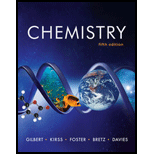
Concept explainers
(a)
Interpretation: The odd-electron molecules among the given chlorine oxides are to be identified.
Concept introduction: A molecule is said to be an odd-electron when the sum of the valence electrons of all the atoms in a molecules is odd that is the total number of bonds formed in a molecule is a fraction.
To determine: If the given chlorine oxide is an odd-electron molecule.
(a)
Answer to Problem 8.107QP
Solution
The molecule
Explanation of Solution
Explanation
The given molecule is
The total number of valence electrons is calculated as,
The total number of valence electrons in
One bond contains two electrons. Therefore, the number of bonds formed in
(b)
To determine: If the given chlorine oxide is an odd-electron molecule.
(b)
Answer to Problem 8.107QP
Solution
The molecule
Explanation of Solution
Explanation
The given molecule is
The total number of valence electrons is calculated as,
The total number of valence electrons in
The number of bonds formed in
(c)
To determine: If the given chlorine oxide is an odd-electron molecule.
(c)
Answer to Problem 8.107QP
Solution
The molecule
Explanation of Solution
Explanation
The given molecule is
The total number of valence electrons is calculated as,
The total number of valence electrons in
The number of bonds formed in
(d)
To determine: If the given chlorine oxide is an odd-electron molecule.
(d)
Answer to Problem 8.107QP
Solution
The molecule
Explanation of Solution
Explanation
The given molecule is
The total number of valence electrons is calculated as,
The total number of valence electrons in
The number of bonds formed in
(e)
To determine: If the given chlorine oxide is an odd-electron molecule.
(e)
Answer to Problem 8.107QP
Solution
The molecule
Explanation of Solution
Explanation
The given molecule is
The total number of valence electrons is calculated as,
The total number of valence electrons in
The number of bonds formed in
Conclusion
The molecules,
Want to see more full solutions like this?
Chapter 8 Solutions
Smartwork5 Printed Access Card for Use with Chemistry: The Science in Context 5th Edition (SmartWork Access Printed Access Card)
 ChemistryChemistryISBN:9781305957404Author:Steven S. Zumdahl, Susan A. Zumdahl, Donald J. DeCostePublisher:Cengage Learning
ChemistryChemistryISBN:9781305957404Author:Steven S. Zumdahl, Susan A. Zumdahl, Donald J. DeCostePublisher:Cengage Learning ChemistryChemistryISBN:9781259911156Author:Raymond Chang Dr., Jason Overby ProfessorPublisher:McGraw-Hill Education
ChemistryChemistryISBN:9781259911156Author:Raymond Chang Dr., Jason Overby ProfessorPublisher:McGraw-Hill Education Principles of Instrumental AnalysisChemistryISBN:9781305577213Author:Douglas A. Skoog, F. James Holler, Stanley R. CrouchPublisher:Cengage Learning
Principles of Instrumental AnalysisChemistryISBN:9781305577213Author:Douglas A. Skoog, F. James Holler, Stanley R. CrouchPublisher:Cengage Learning Organic ChemistryChemistryISBN:9780078021558Author:Janice Gorzynski Smith Dr.Publisher:McGraw-Hill Education
Organic ChemistryChemistryISBN:9780078021558Author:Janice Gorzynski Smith Dr.Publisher:McGraw-Hill Education Chemistry: Principles and ReactionsChemistryISBN:9781305079373Author:William L. Masterton, Cecile N. HurleyPublisher:Cengage Learning
Chemistry: Principles and ReactionsChemistryISBN:9781305079373Author:William L. Masterton, Cecile N. HurleyPublisher:Cengage Learning Elementary Principles of Chemical Processes, Bind...ChemistryISBN:9781118431221Author:Richard M. Felder, Ronald W. Rousseau, Lisa G. BullardPublisher:WILEY
Elementary Principles of Chemical Processes, Bind...ChemistryISBN:9781118431221Author:Richard M. Felder, Ronald W. Rousseau, Lisa G. BullardPublisher:WILEY





